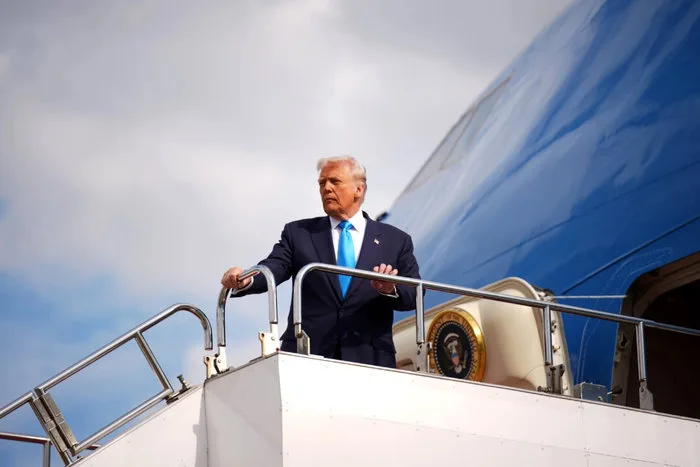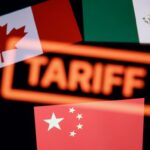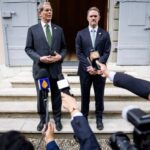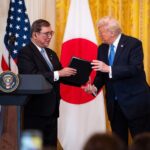By Catherine Yang
U.S. President Donald Trump is in Gyeongju, South Korea, hours away from capping off his busy Asia tour with a high-stakes meeting with Chinese Communist Party (CCP) leader Xi Jinping on Oct. 30.
The two leaders will sit down at 11 a.m. for a meeting that could last up to two hours before Trump departs for Washington.
Trump met with South Korean President Lee Jae Myung on Oct. 29 to discuss investments and security, but no trade deal was signed.
Xi will remain in South Korea on Nov. 1 and hold a bilateral meeting with the South Korean president.
American and Chinese trade negotiators said on Oct. 26 they had reached a framework for an agreement between the two countries and that a deal is expected to come out of the Trump–Xi meeting.
An ‘Everything’ Deal
A myriad of issues are on the table as the two leaders meet to discuss tariffs, fentanyl, global supply chains, Indo-Pacific security, and political prisoners.
Chinese spokespersons, who confirmed the meeting on Oct. 29, called the high-level relationship between Trump and Xi “irreplaceable” in strategic relations between the two countries and said it would be an “in-depth” exchange.
Trump has said the list of issues he wants to raise with Xi is long, and he expects cooperation and concessions from Beijing on several of them.
Trump and U.S. officials have also signaled that 100 percent tariffs are no longer on the table, given that Beijing is expected to hold off on a disruptive export restriction program for rare earths.
The United States and China had imposed tariffs reaching triple digits on each other back in April amid escalating tensions, but those tariffs have been paused several times to make room for negotiations. The next deadline is Nov. 9, which may be pushed again if no final deal is reached in the Oct. 30 meeting.
Beijing is expected to hold off on its latest rare-earth export controls for about a year as it reviews the rule, while Trump is accelerating the diversification of the supply chain. The U.S. president signed agreements with Thailand, Japan, and Malaysia in the past few days.
Also high on the list is American farmers, whom Trump said Beijing had been trying to use as “leverage.”
China is the largest buyer of U.S. soybeans, purchasing more than every other buyer combined. This year, amid a record harvest, China boycotted U.S. soybeans and purchased its fill from Brazil and Argentina instead, leaving American soybean farmers in the lurch.
Farmers’ associations appealed to Trump, Chinese officials urged U.S. farmers to lobby to reduce tariffs, and Trump said he would use tariff revenue to bail out the farmers in the short term.
Trump has previously said he wants China to “quadruple” its purchases of U.S. soybeans.
While many nations have signed trade deals that allow them to effectively “buy down” their trade deficits with the United States through multibillion-dollar investments rather than purchases of U.S. goods, national security concerns are likely to prevent Beijing from doing the same. Trump has said he expects a “deal on everything” rather than a traditional trade deal.
Beijing is also expected to curb exports of fentanyl precursor chemicals and do its part in cracking down on drug trafficking that is causing a crisis in the United States, Trump told reporters aboard Air Force One on Oct. 28. Trump has said he expects to announce a reduction of the 20 percent fentanyl-related tariff imposed by Washington on China if Beijing agrees to cooperate on this issue.
Moreover, Trump has said he will bring up the Russia–Ukraine war, Taiwan, and that he will ask for the release of political prisoner Jimmy Lai, a Hong Kong pro-democracy media mogul who has been imprisoned since 2020.
Nvidia Valuation Skyrockets
New on the list is the issue of Nvidia’s cutting-edge Blackwell AI chip, which Trump brought up on Oct. 29.
He told reporters that the flagship Blackwell “super-duper chip” was something he may speak to Xi about, sending shares rallying. Nvidia on Wednesday became the first company to reach a market value of $5 trillion.
Nvidia chip sales to China have been thrown for a loop amid this year’s trade war. The Trump administration initially planned to further restrict sales of Nvidia chips to China, but reversed course after Trump spoke with Nvidia CEO Jensen Huang.
However, Beijing expressed suspicion about the reversal, citing security concerns about “backdoors” and location tracking, and summoned Nvidia to provide information and assurances. Nvidia did not disclose what information Beijing sought, but denied the existence of any backdoors.
Meanwhile, Chinese authorities and associations urged Chinese companies to use domestic chips over foreign purchases. Huang said at Nvidia’s developers’ event on Oct. 29 that he hasn’t applied for export licenses to China as a result.
“They’ve made it very clear that they don’t want Nvidia to be there right now,” he said of China.
Huang, who on Tuesday announced $500 billion in AI chip orders and plans to build seven supercomputers for the U.S. government, is also expected to meet with Trump on Oct. 29.
“When I go, hopefully we‘ll have some announcements that will be really, really delightful to the people of Korea and really delightful to President Trump, but I’ll save it for a few more days,” Huang told reporters ahead of the South Korea trip.
Competition Intensifies
Both the United States and China are also trying to project power through diplomacy in the Indo-Pacific.
Trump, U.S. officials, and their foreign counterparts have underscored the prominence of American leadership in the Indo-Pacific as the Asian nations look to the United States for security.
In addition to trade deals, Trump signed agreements that would boost cooperation to combat transnational crime, allow for joint military drills, and increase collaboration and investments in cutting-edge technology.
Chinese officials have meanwhile urged nations to cooperate with China to push back against U.S. tariffs, criticizing them as “protectionism.”
Reuters contributed to this report.






